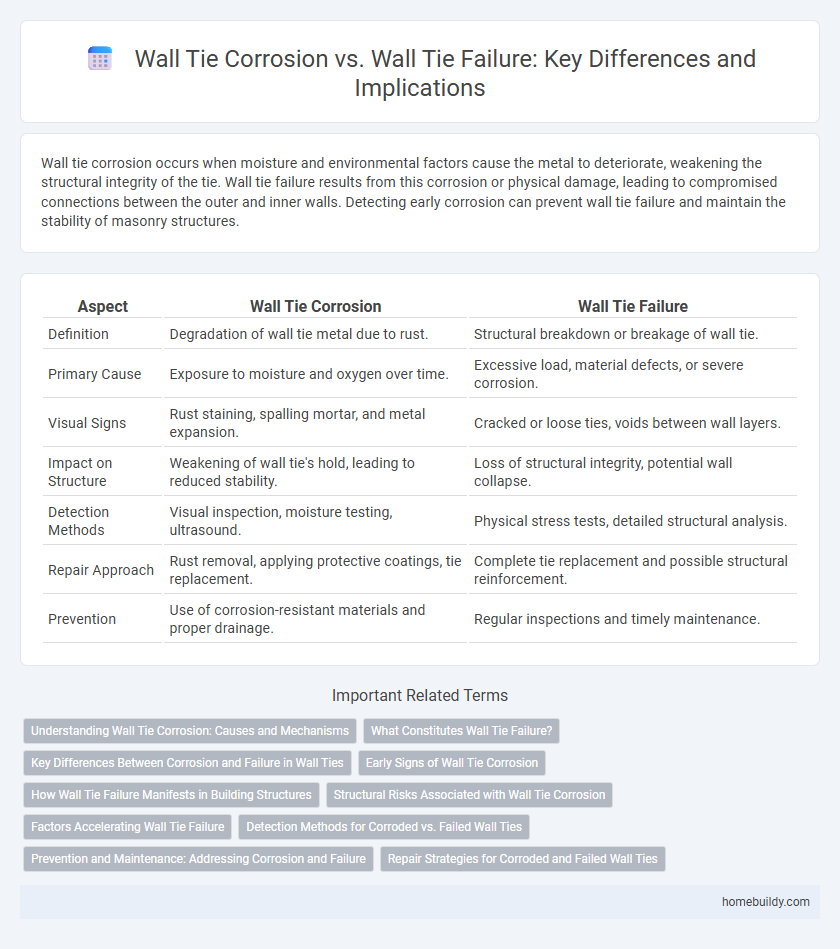Wall tie corrosion occurs when moisture and environmental factors cause the metal to deteriorate, weakening the structural integrity of the tie. Wall tie failure results from this corrosion or physical damage, leading to compromised connections between the outer and inner walls. Detecting early corrosion can prevent wall tie failure and maintain the stability of masonry structures.
Table of Comparison
| Aspect | Wall Tie Corrosion | Wall Tie Failure |
|---|---|---|
| Definition | Degradation of wall tie metal due to rust. | Structural breakdown or breakage of wall tie. |
| Primary Cause | Exposure to moisture and oxygen over time. | Excessive load, material defects, or severe corrosion. |
| Visual Signs | Rust staining, spalling mortar, and metal expansion. | Cracked or loose ties, voids between wall layers. |
| Impact on Structure | Weakening of wall tie's hold, leading to reduced stability. | Loss of structural integrity, potential wall collapse. |
| Detection Methods | Visual inspection, moisture testing, ultrasound. | Physical stress tests, detailed structural analysis. |
| Repair Approach | Rust removal, applying protective coatings, tie replacement. | Complete tie replacement and possible structural reinforcement. |
| Prevention | Use of corrosion-resistant materials and proper drainage. | Regular inspections and timely maintenance. |
Understanding Wall Tie Corrosion: Causes and Mechanisms
Wall tie corrosion primarily results from prolonged exposure to moisture, chloride ingress, and carbonation, which deteriorate the metal's protective layers. This chemical breakdown weakens the structural integrity of the ties before any visible wall tie failure occurs. Understanding these mechanisms helps in early detection and prevention of significant wall tie failures in masonry structures.
What Constitutes Wall Tie Failure?
Wall tie failure occurs when the embedded metal ties lose their structural integrity, compromising the stability of masonry walls. Corrosion is a primary cause of wall tie failure, as rust expands and weakens the metal, leading to cracking or spalling in the surrounding mortar or bricks. Comprehensive inspection and timely replacement of corroded wall ties are essential to prevent structural damage and maintain building safety.
Key Differences Between Corrosion and Failure in Wall Ties
Wall tie corrosion primarily involves the chemical deterioration of metal components due to exposure to moisture and environmental elements, leading to rust and weakening of the tie material. Wall tie failure refers to the loss of structural integrity and function, often caused by severe corrosion but can also result from mechanical stresses or installation defects. The key difference lies in corrosion being the degradation process, while failure signifies the end stage where the wall tie can no longer perform its load-bearing or stabilizing role.
Early Signs of Wall Tie Corrosion
Early signs of wall tie corrosion include rust stains emanating from mortar joints and small cracks in the masonry surrounding the tie area. Metal wall ties experiencing corrosion tend to expand, causing mortar to crack and leading to potential structural weaknesses. Detecting these signs promptly helps prevent complete wall tie failure and costly repairs.
How Wall Tie Failure Manifests in Building Structures
Wall tie failure manifests in building structures through visible signs such as bulging or cracking of external brickwork, misalignment of walls, and increased movement between inner and outer leafs of cavity walls. Corrosion of wall ties reduces their tensile strength, leading to loss of anchorage and structural integrity over time. Monitoring these symptoms is essential to prevent progressive wall detachment and ensure the long-term stability of masonry constructions.
Structural Risks Associated with Wall Tie Corrosion
Wall tie corrosion significantly compromises the integrity of masonry cavity walls by weakening the metal ties that anchor the external brickwork to the internal structure. Corroded wall ties lose tensile strength, leading to bowing walls, cracked mortar joints, and, in severe cases, partial wall collapse, posing serious structural risks. Regular inspection and timely replacement of corroded wall ties are critical to maintaining the safety and stability of buildings.
Factors Accelerating Wall Tie Failure
Factors accelerating wall tie failure include moisture infiltration, leading to corrosion of metal ties, and the use of low-quality or inappropriate materials prone to rust. Poor installation techniques and inadequate wall cavity ventilation further exacerbate corrosion rates, compromising structural integrity faster. Environmental exposure to salt, acid rain, and fluctuating temperatures significantly accelerates degradation of wall ties, increasing the risk of wall tie failure.
Detection Methods for Corroded vs. Failed Wall Ties
Detection methods for corroded wall ties typically involve non-destructive testing techniques such as ultrasonic pulse velocity, radiographic imaging, and half-cell potential measurements to identify early signs of metal degradation within masonry. In contrast, failed wall ties are often detected through visual inspections revealing cracks, bulges, or detachment in the wall, supported by mechanical testing like pull-out tests to confirm loss of structural integrity. Advanced methods such as ground-penetrating radar and infrared thermography enhance accuracy in differentiating between corrosion-induced weakening and complete tie failure in building facades.
Prevention and Maintenance: Addressing Corrosion and Failure
Effective prevention of wall tie corrosion involves using stainless steel or galvanized ties to resist moisture-induced rust, significantly extending structural integrity. Regular maintenance includes inspecting for signs of rust staining, misalignment, or wall bulging, which indicate early failure, allowing timely replacement or reinforcement. Implementing effective drainage and waterproofing systems further reduces moisture exposure, minimizing corrosion risks and enhancing overall wall tie durability.
Repair Strategies for Corroded and Failed Wall Ties
Repair strategies for corroded wall ties emphasize removal of deteriorated metal and installation of stainless steel or non-metallic replacement ties to restore structural integrity. Failed wall ties often require localized masonry repair combined with wall tie reinforcement techniques such as resin or grout injection to bond new ties securely. Timely intervention with appropriate materials prevents progressive wall instability and limits extensive reconstruction costs.
Wall tie corrosion vs Wall tie failure Infographic

 homebuildy.com
homebuildy.com